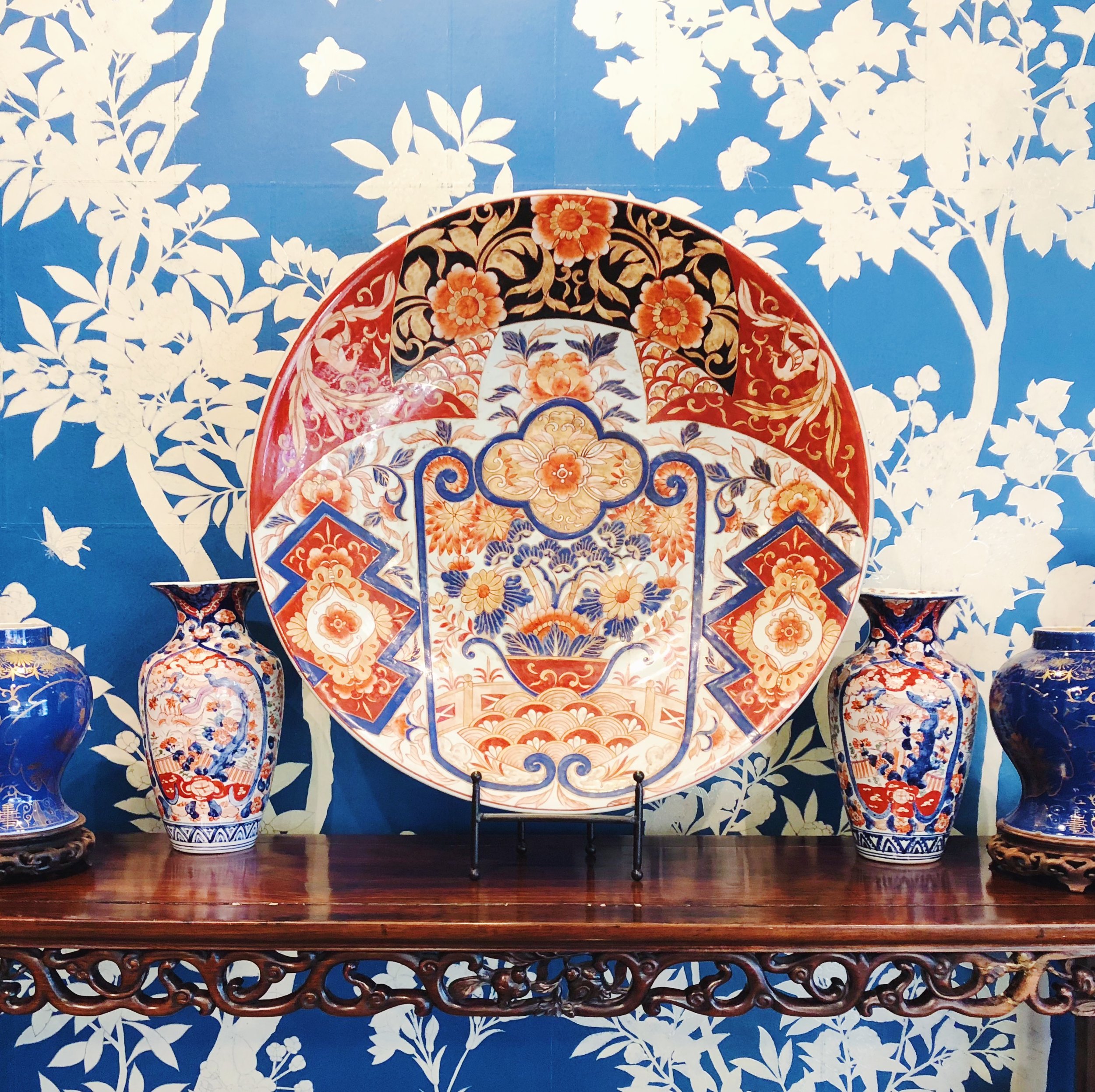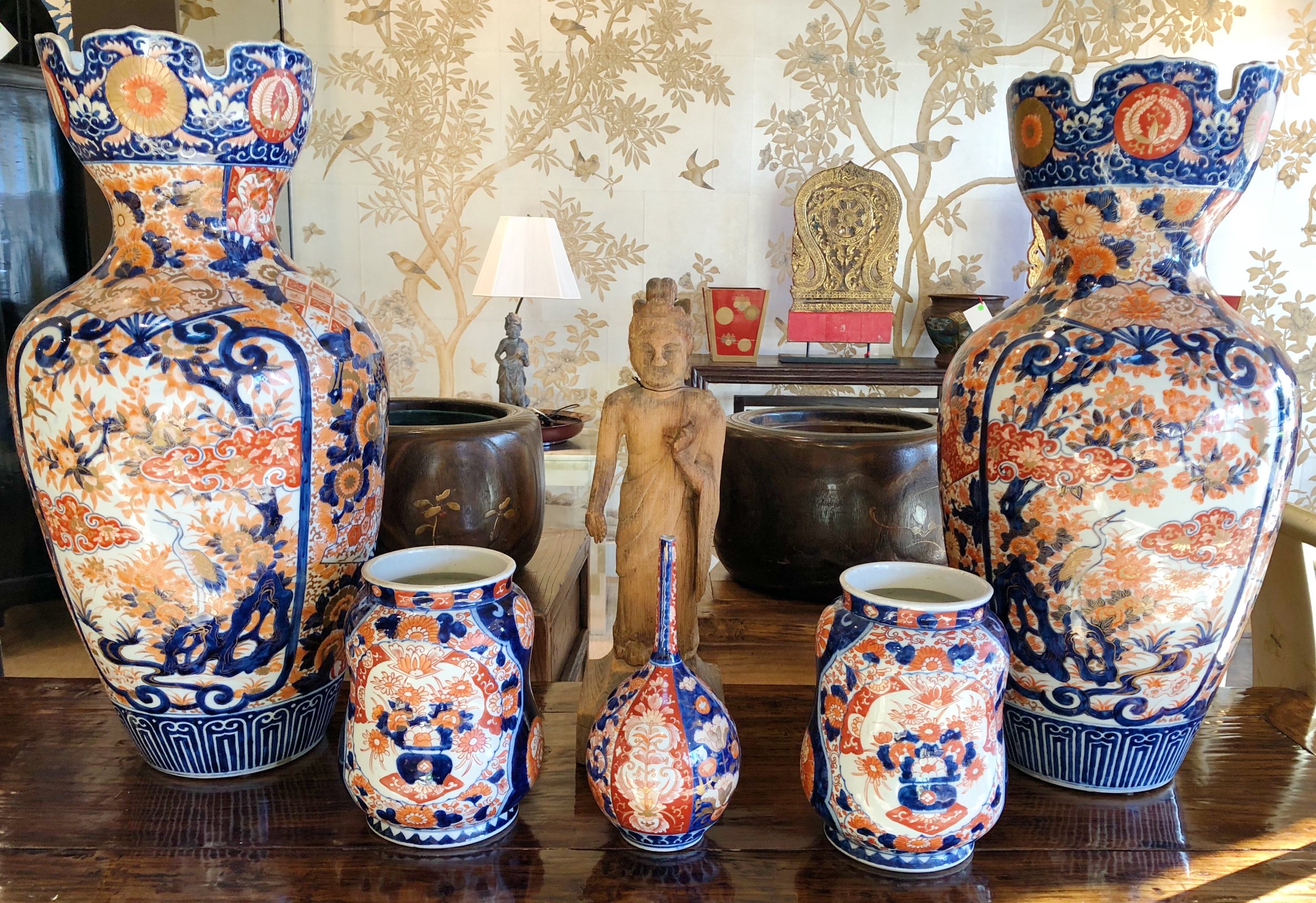Our last interior design blog took a look at the current market for antique collecting, specifically for antique American furniture. In this blog, we'll explore another hobby that has remained popular for decades: collecting Imari porcelain.
History of Imari
Imari porcelain can be Chinese or European in origin, but was first created in Japan. In 1616, the town of Arita became Japan's porcelain production center because it was near Izumiyama, a quarry rich in kaolin clay. The wares were then shipped to the West from the port of Imari, hence the name. The earliest Imari pieces had simple, hand-painted designs in blue against white grounds and were made to be tea bowls, dinner plates, and rice bowls.
By the 1630s, ceramic makers were introducing a wider variety of colors into their pieces. The designs also became more intricate, featuring images of cranes, fish, beautiful women, flowers and gnarled tree branches. These were the most popular images in Japanese textiles at the time. Pieces were under-glazed in blue first, with the blue used to delineate borders and backdrops. Afterward, other colors such as rust red, green, and gold were added and fired at a lower temperature. Imari's iconic color combination proved to be very popular in Europe.
Japan imposed a self-isolation policy in the mid-seventeenth century. The only other nation that could continue trading with them was Holland, so Dutch traders would import Japanese goods (including Imari) and trade them to the rest of Europe. Imari potters began to produce pieces specifically for European tastes. Dutch artists would suggest some ideas for scenes, which might depict geishas, hunting scenes with dogs, or Dutch men and women. Imari wares produced before 1750 are called “Old Imari” and command high prices because of their scarcity.
English factories such as Royal Crown Derby, Minton, and Worcester produced their own versions of Imari. Other European factories included Chantilly in France, Meissen in Germany, and Holland's Delft factories. Chinese potteries also began to release high-quality Imari pieces for export, which flooded the market and drove up prices for scarcer Japanese Imari.
The isolation period ended in the mid-nineteenth century. Now that Imari was more readily available again, its popularity exploded. The designs produced during this period have vivid tomato reds and deep cobalt blues.
Regional Styles
The most prized pieces among Western collectors are the Imari that were produced by the Koransha kiln from the late nineteenth century to the early twentieth century. These are often densely decorated with bold and stylized motifs, including bamboo, koi, and irises.
Japanese collectors tend to prefer 18th century Imari from the Kakiemon and Nabeshima kilns, which had elegantly simple designs in soft colors. Kakiemon is named after Sakaida Kakiemon, who discovered a new technique for applying enamel decoration to porcelain. Although overlooked by many Western collectors, these are the most valuable at auctions today. They are more sparsely decorated in asymmetrical designs of subdued red, blue, yellow, and turquoise green. There was no blue under-glaze and the design of the piece emphasized the fine "milky white" background of the porcelain.
Royal Crown Derby, which produces English Imari to this day, is known for using intricate borders and an abundance of gold detail. French Imari is designed in a similar way. Meissen Imari from Germany are less cluttered than either Derby or Japanese Imari, and feature comparatively simple designs.
You can identify Chinese Imari by its brighter white and more purple-toned blue. The red over-glaze is also thinner and closer to orange than in Japanese pieces. Chinese Imari is generally more finely potted than Japanese, with a very even glaze.
Reading Marks
As you begin to research different types of Imari, you may be drawn to one factory's particular style. You can usually identify which factory produced a piece of porcelain by its mark on the underside. However, don't be surprised when you find antique Imari without any mark at all.
Before 1890, imports to the US were not required to be marked by country of origin. Those that were marked usually listed the name of the importer or manufacturer. Japanese Imari is especially difficult to date. Marks on these pieces can vary from personal signatures, the name of the customer, or the exporter and importer. Sometimes even pieces within the same set can be marked differently.
If you want to become a serious Japanese Imari collector, you'll need to learn to read the names of cities and kiln areas where Imari was made. An English/Japanese dictionary may be required, but there are also handbooks such as Japanese Marks and Seals by James Lord Bowes that you can consult. Imari marked with "Gold Imari, Hand-painted," are vintage Arita wares produced between 1959 and 1984.
Chinese Imari were always given an imperial mark that was either written in normal script or drawn in a special style of seal script. The 'handwritten' script was harder to fake because differences in penmanship would give away a forged piece. Modern Royal Crown Derby pieces are always marked with a crown, the name of one of three factories, and the year the piece was produced. Meissen Imari are marked with crossed swords; the style of the mark determines the age of the piece.
Enjoying Your Collection
Since so much Imari was produced to be exported, you don't have to travel to Japan to find authentic antiques. Even here in Dallas, Imari can be found for fairly competitive prices. And due to their history of craftsmanship, these antiques will continue to rise in value.
One of the draws of Imari collecting is that newcomers can find high-quality, beautifully made pieces at a variety of price points. 19th-century vases, serving bowls, chargers, and platters in three-tone color schemes usually sell for under $1000 apiece. Smaller items, like tea caddies, figurines, and incense burners can also be good pieces for beginners on a budget.
Asian antiques have come back in style and can serve as statement pieces in a variety of homes – from English to French to American. This fine porcelain can add color to your walls in lieu of a painting. Consider also using Imari pieces for table presentation. In addition, a small collection of Imari can mix beautifully with leather-bound books in a den.
If you're shopping for fine porcelain, consider adding Imari to bring a beautiful piece of history to your home. To learn more about how Chambers Interiors can help you source the finest Imari available, call our Dallas office at 214-651-7665 or email us at info@chambersinteriors.com. (Please note that Chambers Interiors does not do appraisals. If you want to learn more about the value of your Imari porcelain, we recommend that you contact your local auction house or appraiser.)



